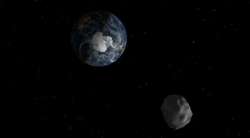Astronomers observe tiniest ever asteroid with a two-metre diameter
A team of astronomers led by an Indian-origin researcher have spotted the smallest asteroid ever characterised – a tiny space rock measuring two metres in diameter. The asteroid, named 2015 TC25, is also one

A team of astronomers led by an Indian-origin researcher have spotted the smallest asteroid ever characterised – a tiny space rock measuring two metres in diameter.
The asteroid, named 2015 TC25, is also one of the brightest near-Earth asteroids ever discovered.
Using data from four different telescopes, astronomers led by Vishnu Reddy, assistant professor at the University of Arizona in the US, found that 2015 TC25 reflects about 60 per cent of the sunlight that falls on it.
Discovered last year, 2015 TC25 was studied extensively by Earth-based telescopes during a close flyby that saw the micro world sailing past Earth at 128,000 kilometres, a mere third of the distance to the moon.
Reddy argues that new observations from the NASA Infrared Telescope Facility and Arecibo Planetary Radar show that the surface of 2015 TC25 is similar to a rare type of highly reflective meteorite called an aubrite. Aubrites consist of very bright minerals, mostly silicates, that formed in an oxygen-free, basaltic environment at very high temperatures. Only one out of every 1,000 meteorites that fall on Earth belong to this class.
“This is the first time we have optical, infrared and radar data on such a small asteroid, which is essentially a meteoroid,” Reddy said.
“You can think of it as a meteorite floating in space that hasn’t hit the atmosphere and made it to the ground – yet,” he said.
Small near-Earth asteroids such as 2015 TC25 are in the same size range as meteorites that fall on Earth.
Astronomers discover them frequently, but not very much is known about them as they are difficult to characterise. By studying such objects in more detail, astronomers hope to better understand the parent bodies from which these meteorites originate.
Asteroids are remaining fragments from the formation of the solar system that mostly orbit the Sun between the orbits of Mars and Jupiter today. Scientists are interested in meteoroids because they are the precursors to meteorites impacting Earth, Reddy said. The discovery also is the first evidence for an asteroid lacking the typical dust blanket – called regolith – of most larger asteroids.
Instead, 2015 TC25 consists essentially of bare rock. The team also discovered that it is one of the fastest-spinning near-Earth asteroids ever observed, completing a rotation every two minutes. Probably, 2015 TC25 is monolithic, meaning it is more similar to a “solid rock” type of object than a “rubble pile” type of object like many large asteroids, which often consist of many types of rocks held together by gravity and friction.
Reddy believes it probably was chipped off by another impacting rock from its parent, 44 Nysa, a main-belt asteroid.
The study was published in The Astronomical Journal.
(With inputs from PTI)